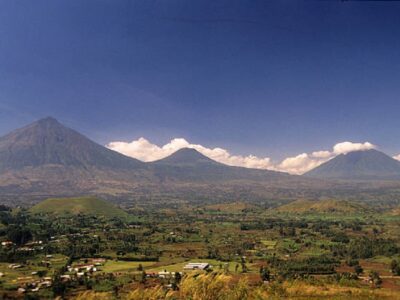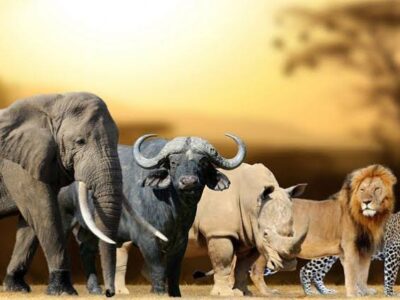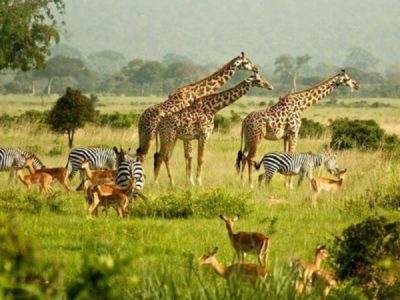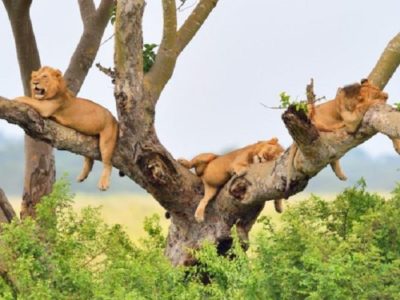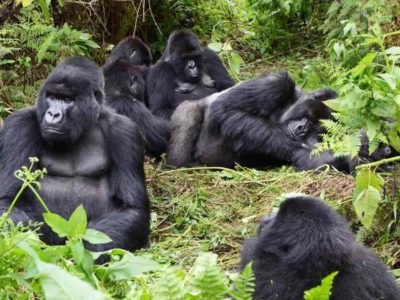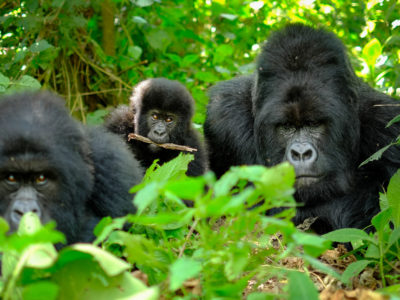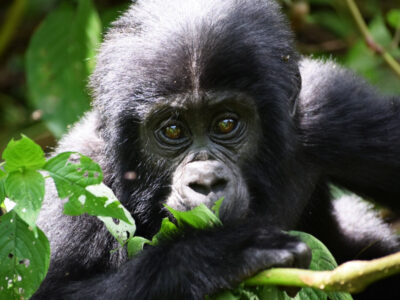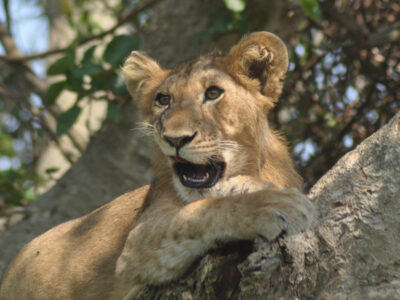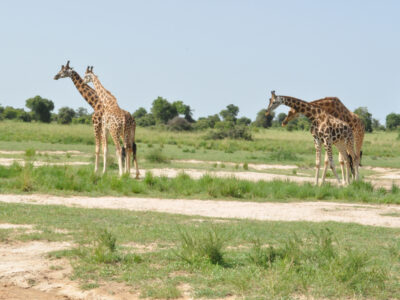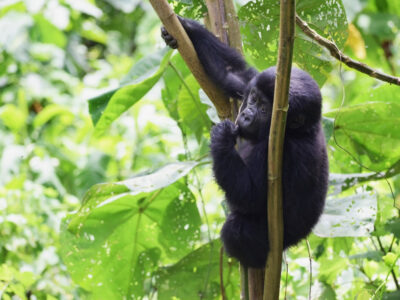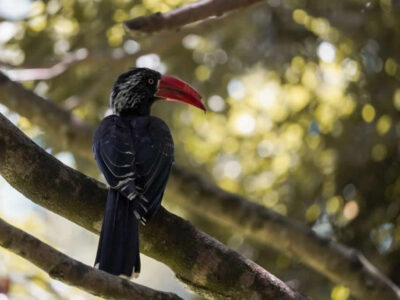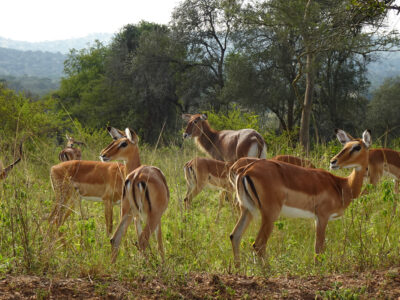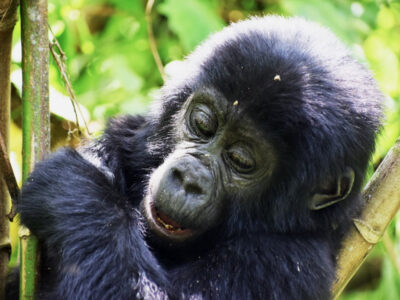This park is one of the outstanding treasures of Uganda, it has been recently been designated a biosphere reserve for humanity. It is the most popular park and easily accessible national park in Uganda. Queen Elizabeth National Park covers an area of 1978 sq. km and includes a remarkable variety of ecosystems from semi-deciduous tropical forests to green meadows and savannahs and swamps.
A total of about 95 mammal species has been recorded here and the highest for any Ugandan national park, it is said to be the home of the antelope species as well as elephants, famous tree-climbing lions the Uganda kobs as well as elephants, hippos, buffalos, baboons, and chimpanzees. A total of around 600 and 15 unconfirmed species of birds has been recorded in Queen Elizabeth national park and this is a truly remarkable number of such relatively small reserve, species recorded include shoebill stock, black bee-eater, kingfishers and a variety of predators, including several falcons and eagles. In the crater lakes, the spectacular flocks of flamingoes gather creating the image of a moving pink carpet.
In the eastern part of the park is the Kyambura gorge where visitors can climb through a tropical forest in hopes of catching a glimpse of a variety of primates including chimpanzees. And in the more isolated Ishasha sector of the park, visitors can move through the woodlands in search of tree-climbing lions perched on the boughs of ancient fig trees. To the southwest, visitors can explore newly opened trails in the Maramagambo forest.
Taking a tour of Queen Elizabeth national park
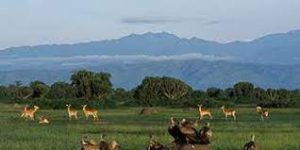
The safaris starts from Kampala from your residence then drive to Queen Elizabeth national park, after about 5 hours’ drive you to stop in fort portal town. The park is the second largest park in Uganda and is located down of the majestic Rwenzori mountains ranges adjacent to Lake Edward and Lake George
The park has plentiful games including the gazelle, Uganda kobs, warthogs, and waterbuck, and lions are often sighted both in and at the entrance to the park, therefore, be prepared for huge numbers of hippos and elephants and your eyes peeled leopards in the sunshine.
This park may require you a three days Uganda tour package to enjoy the variety of wildlife in this park; elephants, buffalos, lions waterbucks, leopards Uganda kobs warthogs, and more. Taking a boat trip along the Kazinga channel you will see a lot of hippos more than you can possibly know as well as a variety of other animals which come to the water shores to drink, except crocodiles and elephants bathing and a range of beautiful birds
Things to do in Queen Elizabeth national park.
Queen Elizabeth national park is one of the places that justify the description of Uganda as “the pearl of Africa”. The scenery is stunning with beautiful forests, woodlands, Savanna, swamps, lakes, rivers, craters, gorges, and landscape. International visitors to this park will never run short of activities. In fact, they might find themselves struggling to complete all of them. The key attractions are nature walks, game drives, boat cruises, chimpanzee trekking, tree climbing lions, and bird watching. If you want to see all the big 5 mammals in Uganda, then you might want to check out our 6 days safari in Murchison Falls and Queen Elizabeth National Park package.
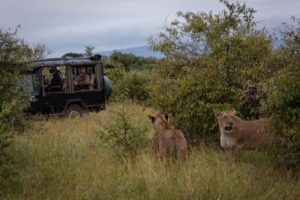
Queen Elizabeth countrywide park is one of the top visited national parks in Uganda that describe Uganda as “the pearl of Africa”. The environment is gorgeous with lovely forests, Savanna, woodlands, swamps, lakes, rivers, craters, gorges, and landscapes. Travelers will in no way run short of things to do as soon as you visit this park. The important sights are game drives, nature walks, boat cruises, chimpanzee trekking, tree mountain climbing lions, and fowl watching. If you desire to spot all the huge 5 mammals in Uganda, then you would per chance choose to take a look at our 7 days safari in Murchison Falls and Queen Elizabeth National Park package.
Game Drives: This is the most popular activity allowing you to see 95 percent of the mammals with better scenery and landscape that includes forests, savanna grasslands, swamp lands, acacia woods, crater lakes, gorges, and the nearby Rwenzori Mountains. The 3-hour game drives start in the early morning to any of the three sectors – the Kasenyi plains, Ishasha sector, or the Katwe crater fields. The crater lakes region has a beautiful landscape with large craters and salt lakes that were formed years ago that act as a water source that attracts elephant flamingos, buffaloes, antelopes, and other creatures during the drier season.
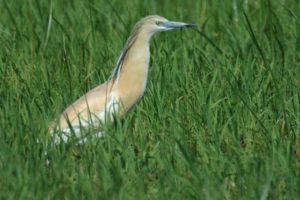
Bird watching: Queen Elizabeth National Park is a top birding vacation spot in Uganda. The full list of the birds in the park can be determined at the Bird Observatory in Mweya. Birders on a tour of Queen Elizabeth National Park will be noticeably impressed with several species inhabiting the forests like Budongo, the Kazinga Channel, crater lakes, and Kyambura gorge. During dry seasons of the year, millions of migratory birds come to break out of the harsh winters in Europe making the park a true birder’s heaven. Among the bird species to seem to be out for are the Yellow-backed, Slender-billed, shoebill stork, Saddle-billed Storks, Red-chested Sunbirds, pink-backed pelican, Malachite and Pied Kingfishers, Little Stint, Lesser Masked Weavers, Lesser and Greater Flamingo, Grey-headed Kingfishers, Grey-headed Gull, Grey-capped Warbler, Great-white, and Pink-backed Pelicans, Greater Swamp and winged Warblers, Slender-tailed Nightjars, Common Squacco Heron, Common Snipe, common sand Martins, common Greenshank, Chapin’s flycatcher, African Broadbill, and African beautiful Black-headed Gonolek.
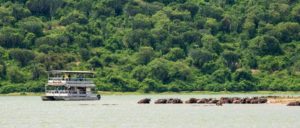
Launch Cruise: This boat tour is organized along the Kazinga Channel, which is one of the best places to view wildlife in Africa. This channel connects Lake George to Lake Edward and is the main point of entry for most of the animals in the park. The bird migration season is a great time to see a different variety of birds in the Kazinga Channel than you would find in North America. The sheer density and variety of wildlife at the channel will amaze even experienced safari-goers. Hippopotamuses, water birds, and crocodiles live in bodies of water, while elephants, antelopes, and predators like leopards drink water in the shallow end of the channel. Tickets for this activity are sold at the Visitor Information Center in Mweya for $30.The activity is organized in shifts throughout the day with the option of using the cheaper public boats or Mweya Safari Lodge’s more expensive private boats
Spot Tree Climbing Lions: The Queen Elizabeth National Park is home to rare tree-climbing lions. They are not sub-species, and there is no reason to think they are different from lions found in other national parks in Uganda. It happens that the local lions have adapted to a life of climbing the numerous fig trees after the morning hunt or during the midday heat. Scientists have not given a clear explanation for why these lions climb trees, but there are theories that they do so because of insects and parasites on the ground. The game drives in the Ishasha sector are organized to look for the lions in the trees. Other mammals to see include warthogs, buffaloes, and elephants.
Chimpanzee Trekking at the Kyambura Gorge: Chimpanzees are one of the most intriguing primates on earth. Chimpanzees can be tracked at the Kyambura Gorge of Queen Elizabeth National Park. The Kyambura gorge is a deep valley in the western section of the park that was created by the strong waters of the river Kyambura. This underground forest is home to several species of primates including baboons, Black-and-white Colobus, and Red tailed monkeys.
Visiting the gorge is not all about primates but also an opportunity to see birds, snakes, butterflies, and other water bodies. It is also an opportunity to learn about vegetation species found nowhere else on earth. The chances of seeing chimps are very high in the morning though not compared to Kibale National Park. If you are interested in combing game drives and chimpanzee tracking in Kyambura Gorge, you should check out this 7 Days Uganda wildlife safari.
Wildlife Research Tours: The Uganda Wildlife Authority introduced research tours to learn about natural world conservation due to high demand from natural world fanatics while additionally allowing vacationers close encounters with wildlife. One of the most famous activities is the lion and Mongoose tracking in Queen Elizabeth National Park. During this activity, the massive cats are observed using radio collars inserted around their neck. The travelers watch as researchers and park staff deal with the cats and screen their movements. During the tracking, other cats like leopards and hyenas can additionally be noticed.
Nature Walks: Visiting the Maramagambo forest is very popular, especially with birders. Nature walks are organized in this large forest using established trails to learn about forest conservation while also spotting small crater lakes, birds, primates, and other forest creatures. Maramagambo forest has about 9 species of primates including chimpanzees, L’Hoest’s monkeys, Vervet monkeys, bush babies, red-tailed monkeys, and baboons. One of the trails leads to a group of caves that are home to thousands of bats. These bats attract large rock pythons that love to feed on them. It is possible to spot both bats and pythons from a safe viewing area. The chimpanzees found in Maramagambo are not yet fully habituated but can still be sighted during long walks to the forest interior.
Visiting the Lake Katwe Salt Mines: Lake Katwe is one of the few salt lakes in East Africa. The lake has no wildlife because of the high salinity. Despite that, the area around the lake is a beehive of activity especially during the dry season as villages gather to remove salt from the milky waters. Salt mining has survived in Katwe for centuries and was once very lucrative until other sources and methods of mining were discovered. Most of the salt used in Ugandan homes originates from Lake Katwe. Salt is still mined traditionally using hands despite the dangers posed by the toxic saline waters. A visit to the mines allows tourists to learn about the salt mining industry while also interacting with the local mining community. Most of the salt is sold to manufacturers while the rest is taken home by the miners.
Cultural Tours: A day trip to Africa and Uganda, in particular, is incomplete besides visiting one of the nearby tribes. On a safari to Queen Elizabeth National Park, an arrangement can be made to go to the Kikorongo Equator Cultural crew to watch and take part in regular dances, drama, and fire-making. While with the Kikorongo Equator Cultural group, site visitors can be taught how to make neighborhood artwork and crafts – like using herbal fibers. Many of these artifacts are accessible for sale at reasonable prices. The possibilities for cultural experiences are severe with nearly every lodge and lodge arranging their personal excursions for their residents.
QUEEN ELIZABETH NATIONAL PARK ACCOMMODATION
Queen Elizabeth national park has fascinating and beautiful accommodation both lodges and hotels where you take a rest and relax for the night after a long game drive throughout the park some include the following;
Mweya Safari Lodge
This will give you a comfortable and forgettable experience while at the park, it is located on the peninsular in Queen Elizabeth national park, it is surrounded by a lot of nature that is flora and fauna, on its eastern side there is Kazinga channel meandering and connects the waters of Lake George and Edward
The lodge has a beautiful swimming pool full of peace and relaxation, this will take your thirst away while enjoying the drink from the bar. It also offers ample room space for conferences and meetings both inside and in an open-air space however there are few interruptions by the animals but this should not worry you for there is a trained staff in wildlife.
Ishasha Wilderness Camp: This lodge is located in the southern part of the park in the Ishasha area, better than Mweya Safari Lodge, Ishasha lodge areas are not surrounded by a lot of wild animals therefore this will give you time to relax and rejuvenate the bad fumes, it has a clear view area where you can see elephants and buffalos on the lake.
Kasenyi Safari Camp: It is located in the salty areas of Lake Bunyampanka and the savannah areas within Queen Elizabeth national park. A lot of animals regularly visit the site in different time frames during the day and evening and at night like Lions, Leopards, and Antelopes. It has a spectacular view due to its landscape which gives you access to morning game drives before you embark on your trip.
Enganzi Lodge: It is located on the hills along Queen Elizabeth National Park boarders with a panorama view with free access to famous wildlife in the park, it has cottages arranged downwards giving you a clear view of the savannah grasslands. Their cottages are grass thatched which allows a cool temperature all the time and are well equipped with a relaxed bed to make you have a comfortable rest all night.


